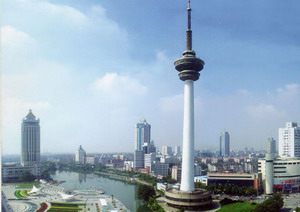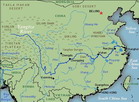2020 Yangtze River Cruise and Ferry Starting from 79 USD p.p.!
Nantong
Nantong is one of the 14 port cities
opened to foreign investment projects under
China's current policies of modernization. The
city is an integral part of the Shanghai Economic
Zone.  The population of 7.4 million is engaged
in industrial production, especially textiles.
It is hoped that textile, precision machinery
and communications industries will be established
either as joint ventures or entirely foreign
enterprise. Ten thousand-ton vessels berth at
its deep-water harbour.
The population of 7.4 million is engaged
in industrial production, especially textiles.
It is hoped that textile, precision machinery
and communications industries will be established
either as joint ventures or entirely foreign
enterprise. Ten thousand-ton vessels berth at
its deep-water harbour.
One of the city's heroes was Cao
Gong, who in 1557 usefully defended the town
against Japanese pirates roaming the coast of
China. His heroic exploits earned him a high
official position which he refused to accept.
Cao was killed in another pirate raid shortly
after. The Cao Gong Zhu Memorial Temple was
built in his honor.
East of the city is Lang Shan (Wolf
Hill), said to be haunted by the sprit of a
white wolf. The temple on top is dedicated to
a Song-dynasty Buddhist monk, whom legend endowed
with magical powers over water demons. Boat
people prayed to him for safe journeys. The
main hall contains models of different types
of river craft. At the base of Lang Shan is
the Five Hills Park.
Bao Shan
The giant Baoshan Steel Works on
the south bank, near the mouth of the Huangpu
River, is one of the largest in China, Japanese
and West German technology and plant are being
used. In the early states the project ran into
difficulties, not the least of which was the
choice of site-marshy ground that caused subsidence.
Moreover, the estuary was found to be too shallow
to allow 100, 00-ton freighters bearing imported
iron ore to unload. The mill began operation
in 1985.
Huangpu River
Just below Baoshan, boats pass by
a large light house and between buoys to turn
south into the Huangpu River, on the last stage
of the journey from Chongqing to Shanghai. The
25- kilometer (13-mile) cruise today takes one
through the heart of Shanghai's port; on either
side of the muddy river stretch wharf installations
with facilities to handle ocean-going ships
of 25,000 tons, and an annual shipping volume
of about 100 million tons. This is China's largest
port and it’s busiest. Apart from the
hundreds of foreign and Chinese registered ships,
the river is busy all day long with ferries,
naval and police craft, lighters and draggers.
kilometer (13-mile) cruise today takes one
through the heart of Shanghai's port; on either
side of the muddy river stretch wharf installations
with facilities to handle ocean-going ships
of 25,000 tons, and an annual shipping volume
of about 100 million tons. This is China's largest
port and it’s busiest. Apart from the
hundreds of foreign and Chinese registered ships,
the river is busy all day long with ferries,
naval and police craft, lighters and draggers.
The Huangpu is 114 kilometer(70
miles) in length, rising from Dianshan Lake
southwest of Shanghai. Its banks were once simply
mud flats. The river is subject to heavy silting
from Yangtze and requires constant dredging
to keep the channels free.
Soon after entering the river, on
the western bank is the area known as Wusong,
where in 1842, during the Opium War, a fleet
of British warships and support vessels hour
bombardment they forced their way up to Suzhou
Creek and on to Shanghai. The fort was heroically
defended but the Chinese were no match for the
British Fleet, Among the many Chinese casualties
was highly respected 76-year-old admiral who
had been at sea of 50 years and who, it was
said, wrapped himself in cotton wool before
his battles to make himself invulnerable. This
was a decisive battle, for it enable his battles
the fleet to occupy Shanghai and move on up
the Yangtze; later in the year, the Treaty of
Nanking was signed, opening many Chinese cities
to foreign trade.
Before the opium trade was legitimized
in 1860, opium clippers and steamers unloaded
their cargo on to hulks permanently moored at
Wusong, Shanghai’s outer anchorage, before
they where smuggled into the hinterland.
Gradually Shanghai’s imposing
skyline appears as boats sidle up to the berth
alongside Zhongshan Lu, once known as the Bund,
and lined with impressive European-style buildings
from a bygone era.



